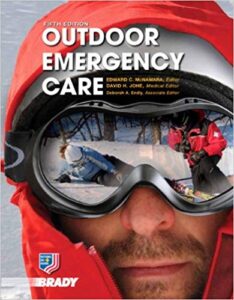Description
Outdoor Emergency Care 5th Edition by National Ski Patrol – Test Bank
Chapter 4
1. A multiple-casualty incident (MCI) is defined as:
- any event that places an excessive demand on rescue personnel and equipment.
- any event in which the number of patients requiring care is greater than 10.
- any event that requires the medical director to leave the hospital and direct activities on scene.
- any event in which five or more people are injured and require transport to different hospitals.
Answer: a
Objective: Supplemental
Reference: 114
2. The National Incident Management System (NIMS) is beneficial in an emergency response to a disaster or a terrorism attack because it provides for:
- specific codes and terms to enhance communications among EMS, fire, and law enforcement personnel.
- increased funding and reimbursement for any EMS agency involved in the response.
- a consistent approach to managing a disaster when the response involves many different responders and agencies.
- federal control of any disaster scene regardless of location.
Answer: c
Objective: Supplemental
Reference: 100
3. Which one of the following statements about the Incident Command System is true?
- Each EMS agency can use its own codes and terms.
- There is a separate commander for EMS, fire, and law enforcement personnel.
- Each individual responder is accountable to two supervisors.
- Common terminology is used for all communications.
Answer: d
Objective: 4-1
Reference: 123
4. While responding to an MCI drill involving an explosion, you recognize that a dozen ambulances sitting in a parking lot three blocks away from the incident constitute the:
- transport unit.
- staging unit.
- treatment unit.
- triage area.
Answer: b
Objective: 4-2
Reference: 108
5. You correctly identify the primary benefit of triage when you say:
- “Triage is a process by which the number of patients is quickly estimated so the appropriate resources can be summoned.”
- “Triage is a system that can be used to determine the number of patients who will most likely die.”
- “Triage is a system used to assign the order of care when an incident contains more than 10 patients.”
- “Triage is used to prioritize patients for treatment and transportation based on their clinical signs and symptoms.”
Answer: d
Objective: Supplemental
Reference: 114
6. Approximately 15 trucks and cars have been involved in a “chain-reaction” collision. You are the first person on scene and begin going from vehicle to vehicle to determine the severity of each injury and to prioritize patients for treatment. Your actions are an example of:
- secondary triage.
- emergency triage.
- primary triage.
- tertiary triage.
Answer: c
Objective: Supplemental
Reference: 112
7. At a multiple-casualty incident, you are brought a patient with a red tag tied to his wrist. You should recognize which one of the following?
- immediate care and transport of the patient are necessary.
- delayed care and transport of the patient are permissible.
- the patient has a minor wrist injury.
- the patient is deceased.
Answer: a
Objective: 4-3
Reference: 115
8. Which one of the following triage tags indicates the lowest priority for care for a patient at a multiple-casualty incident?
- A yellow tag
- A red tag
- A black tag
- A green tag
Answer: c
Objective: 4-3
Reference: 117
9. You are transporting a patient at a multiple-casualty incident. The patient has a yellow triage tag. You understand this tag to mean:
- treatment of the patient could be delayed for up to 4 hours.
- the patient has minor injuries.
- the patient should be with the “walking wounded.”
- the patient has a head injury.
Answer: a
Objective: 4-3
Reference: 116
10. In the Simple Triage and Rapid Transport (START) system for triaging patients, what should you include in your assessment to determine the order in which patients will receive emergency care?
- Chief complaint, respiratory rate, pulse, medications the patient is using
- Respiratory rate, pulse, mental status, ability to walk
- Level of consciousness, pulse, past medical history, medications the patient is using
- Chief complaint, ability to walk, pulse, past medical history
Answer: b
Objective: 4-4
Reference: 120
11. You are at a college football game when a bleacher collapses. Several injured people are walking around with various injuries. Which of the following instructions is most appropriate for these ambulatory patients?
- “Go outside and wait by the red fire truck in the parking lot.”
- “Sit down here so I can do a quick assessment on you.”
- “Put this yellow tag on your wrist and go outside to the red fire truck in the parking lot.”
- “Leave the football stadium and go to the hospital. Others are hurt more seriously than you.”
Answer: a
Objective: 4-3
Reference: 120
12. There is a fight involving approximately 20 bar patrons. Weapons were used, and there are varying degrees and types of injuries. The first person on scene has started assessing a person lying on the floor with blood covering his shirt. Quick assessment reveals him to be breathing at 24 times per minute. Which of the following actions should be done next?
- Assist ventilation with a BVM.
- Check for a radial pulse.
- Attend to the next patient.
- Place a yellow tag on his wrist.
Answer: b
Objective: 4-4
Reference: 120

Reviews
There are no reviews yet.